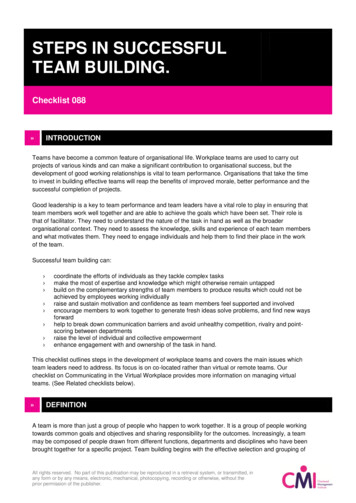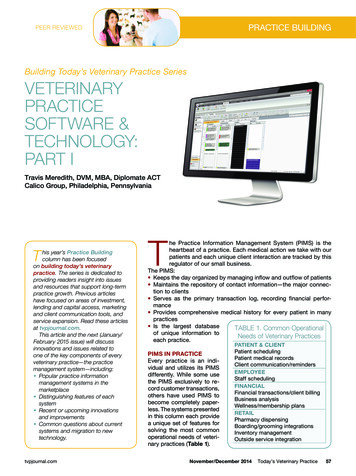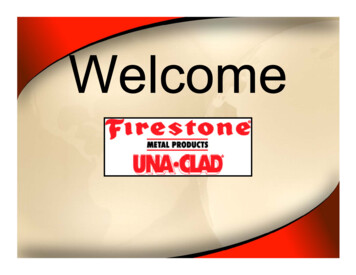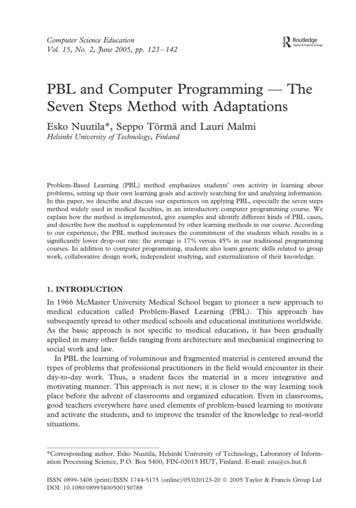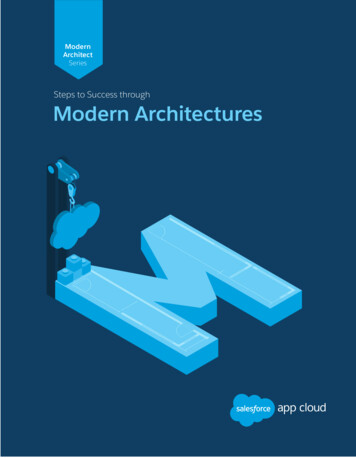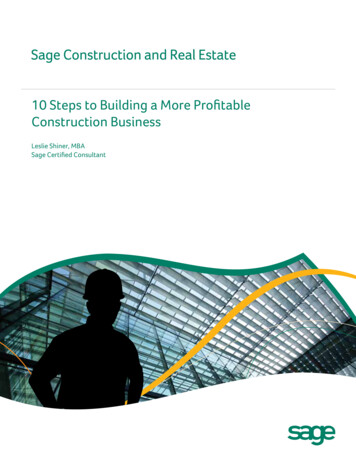
Transcription
10 Steps to Building a More ProfitableConstruction BusinessLeslie Shiner, MBASage Certified Consultant
Introduction10 Steps to Building a More Profitable Construction Business is a pragmatic approach todeveloping business practices that result in greater profitability. The lessons here apply whetheryou’re a general contractor, builder or subcontractor working in residential, commercial, homebuilding or any number of specialty construction trades. The 10 steps that follow are basedupon the concept of the profit cycle—a complete, four-part cycle designed to help constructionprofessionals learn from their mistakes and repeat their successes. As you will see, the goal is notto work more, but to work more effectively— and improve your company’s bottom line as you go.10 Steps to Building a More Profitable Construction Business contains strategies that can beused effectively in any number of ways. Ultimately, the key to success is the integration of everystep within the profit cycle—yet substantial results can be realized by selecting and implementingonly a few of these steps every month.About the AuthorLeslie Shiner has an MBA degree from U.C. Berkeley with an emphasisin Finance and Accounting. She has over 20 years experience providingfinancial management services to the construction industry. She leadsconstruction accounting and project management seminars around thecountry and frequently speaks at national conferences. Leslie has servedas an Adjunct Faculty member at Dominican University, San Rafael, CA.and at Sonoma State University.210 Steps to Building a More Profitable Construction Business
STEP 1: Estimating for ProfitCreating a detailed, accurate estimate for the work you propose to do is the first step towardachieving real profitability—yet too many contractors fail to calculate the true cost of a proposedproject based upon three essential elements: overhead, risk and job costs. Each of these elementsmust be reflected in the estimate ahead of time if you expect a profit once the job is completed:Overhead. Understanding overhead is important. Think of overhead as the costs that would remaineven if your crew didn’t do any work for a week. You would still need to pay the bookkeeper,telephone, insurance, rent, and utilities—as an example.Risk. It is important to include risk factors in each estimate—a “contingency” line—rather thanjust padding here and there. That way, you can measure your true costs against a real budget, asopposed to a padded one. Time and materials jobs have the least amount of risk while the biddingprocess for contract jobs includes the most.Job Costs. Labor can be the riskiest and most difficult part of the estimating process. In order toprepare an accurate estimate, you must know how long each task will take and how much eachtask will cost—and that depends on the relative efficiency of your personnel. Without understandingthe true productivity of your field staff, you cannot create accurate and reliable estimates.Take Away It is important to remember that the mathematical difference between the budget and the bid isboth overhead and profit. The goal of an accurate estimate is to determine your true costs–andoffer you the ability to accurately assess the progress and profitability of each job against a predetermined benchmark.STEP 2: Managing Job Production for ProfitOnce you’re awarded a job, it’s crucial to perform the work in the most cost-effective way possible ifyou expect to make a profit. While that may be easy in theory, it can be another matter altogether inpractice. To effectively manage a job, keep these important factors in mind:Change orders. Too many contractors lose money on change orders because they don’tsystematically track costs and don’t take the time to bill for the change work they perform. Ironically,change orders can be an excellent source of additional profit because you have no competition forthe work. In order to better track and manage change orders, you must create procedures to recordchanges in the field, turn those changes into work orders, and obtain signoff on approved work forbilling purposes.People productivity. As Ben Franklin said, “time is money,” and it’s especially true in construction.For example, if you run a job exactly as budgeted, but it took two weeks less to complete thanexpected, you have added profit directly to your bottom line. Why? Because that job will carry twoKeep everyone informed. Both employees and subcontractors need to know the job schedule.Subcontractors appreciate early notice of schedule changes and will be more willing to help you out.310 Steps to Building a More Profitable Construction Business
Take Away Consider the familiar story of the 150 box of staples: if you run out of staples on a job site, the cost ofthose staples amounts to the purchase price of the staples PLUS the cost of the time wasted by thecrew as they stop to look through all the trucks for them PLUS the hourly rate of the most expensiveperson on your crew who must be sent to the hardware store to buy them. And don’t forget thestop for the coffee and donuts. By utilizing a schedule that includes a complete parts list by task,you’ll have all the materials you need on the job each day—and will improve the likelihood of beingprofitable by eliminating unproductive downtime. weeks less overhead.STEP 3: Accounting for ProfitTrue job cost accounting can increase your profitability by helping you understand the actualcosts associated with each job. A proper accounting system needs to accomplish two things:one, effectively meet your daily accounting and bookkeeping needs and two, meet your specificrequirements as a contractor. That means streamlined processing and an effective way to manageworkers’ compensation, liability insurance, bonding and other issues of concern to you.Remember that an accurate construction accounting system must distinguish between overheadcosts and direct job costs. You must also be able to systematically compare your budgeted costs toyour actual job costs to measure estimating effectiveness, labor productivity and use of materials.Assigning the right responsibilities to the right people will help make your accounting system workfor you. To accurately assign costs to a job, your project manager needs to be the one who codesthe bills. If left to your bookkeeping staff, they may assign costs incorrectly since they are not closeto the actual construction work being done. The result is that any report that compares actual tobudgeted costs by cost code will be inaccurate and therefore meaningless.Purchase orders can also help keep your costs in order. Using purchase orders will ensure that theproject manager codes expenses at the time of order, not the bookkeeper, when the bill is received.And without using a PO, you could end up paying more than your supply house originally quoted ifthey make a billing mistake. This could happen because your bookkeeper can’t spot the overchargewithout a PO showing what the correct price should have been.Contractors spend too much time and energy on accounts payable—and without a workablesystem in place, the quantity of incoming invoices will overwhelm your office. Just as important, ifyou do not send receivable invoices in a timely fashion and fail to follow up on them, you’ll quicklyfind you don’t have the cash to take care of the bills.Take AwayAn effective accounting system will enable you to meet daily bookkeeping needs as well as addressissues of special concern to contractors. And better management means better cash-flow—takingyou a step closer to running a more profitable business.410 Steps to Building a More Profitable Construction Business
STEP 4: Analyze for ProfitMany contractors make the mistake of thinking of each job as an independent project—with a startand a stop. As a result, they rarely take the time to analyze each job and assess the overall successof the business. If you think of your projects as circular rather than linear, you will find effective waysto reduce costs and increase profits.Contractors often have trouble ending jobs because they are more focused on starting the next one.Yet it’s important to remember that you won’t get paid until you successfully complete the projectpunch list—and the sooner you do, the sooner you’ll receive payment on the final invoice, as well asthe retention.A thorough review should be built into your closing process. Look for unbilled amounts stilloutstanding from vendors. Look for unbilled change orders. Another important part of the reviewprocess is to compare your actual costs to your budget. Based upon what you learn, you can makeneeded adjustments, which will help you be more profitable on future jobs.Take Away Each job is unique but it’s important to remember that there are many similarities in every projectyou undertake, and that what you learn from each job can be applied to future jobs—insight that willhelp you be more profitable next time.STEP 5: Understand the Profit cycleSince we’re half-way through the “10 Steps” let’s review the construction business profit cycleagain. Within the first 4 of our 10 Steps, there are multiple strategies to pursue. Decide which ofthem would provide the most ROI (return on investment) for your company and implement these.Take Away Profitability depends on your ability to produce better business results in four different areas:1) estimate more accurately, 2) finish jobs faster, 3) implement construction-specific accountingprocesses, and 4) refine job costing.510 Steps to Building a More Profitable Construction Business
STEP 6: Define Goals and Set ExpectationsYou may wish to take some time to seriously consider and define your goals for your business. Thiswill be your roadmap to follow. Once you’ve defined your own goals, then you’re in a good positionto guide your employees’ and clients’ expectations and behavior to serve your vision and theirs.Define Goals. Really take some time to consider what you want to achieve in your business. Do youdefine success by your bottom line? By company growth? Spending more time with family? Hereare some important things to keep in mind as you define success.Too many companies define success in the short-term—an error that may ultimately damage yourbusiness. An emphasis on long-term planning and relationships over short-term gains will helpensure the ongoing success of your company.We recommend some practical ways to define your goals that include use of a mission statementand complete business plans. Crafting a mission statement will help you systematically identify yourvalues, your focus and what you hope to achieve. Business plans, on the other hand, require youto set realistic, detailed long-term management, financial and marketing goals and enable you tomeasure your success against them.Set Expectations. Setting expectations will influence the behavior of your clients and youremployees and result in more productive, long-term relationships. Consequently, you will be in abetter position to achieve your own goals.Clients. Repeat clients and referrals not only reduce your marketing expenses, but can dramaticallyincrease your business volume and profitability. That’s why it’s so important to set expectations toinfluence your customer’s view of your work.Here are some important tips for setting expectations: Your clients need to know in advance that it’s typical to have additional costs 10% to 25%more than the original contract from change orders. A client who has a realistic expectationof change orders and resulting costs will be far more willing to work with you during thejob—and pay for the additional work you do. Don’t forget to ask for referrals. Use your company signs at each job. Inform the neighborsthat you’ll be working in the area. Use each contact as an opportunity to do direct marketingfor your business. Sometimes, as difficult as it is, you may need to fire a bad client. Miserable clients, whohave unrealistic expectations, make for unsatisfactory and highly unprofitable jobs.Employees. Your employees also need to know your goals and expectations. Employees whohave shared goals will be more effective in performing their jobs. Sharing profits can go a longway toward creating shared vision and goals. Find out what makes each of your employeeshappy—better wages? increased responsibilities? fewer work hours?—and use that informationas you work with them. Some employees are content to do the same job year in and year out.Others look for additional responsibility. Let your employees know what advancement path isavailable to them—and encourage them to succeed at it.610 Steps to Building a More Profitable Construction Business
Employees are far more satisfied when they are held accountable for tasks they can control. Beclear about who is responsible for what, and then hold those individuals accountable. For example,it is difficult to make the bookkeeper responsible for coding invoices to the correct cost codes if heor she is not the project manager.Take Away Each job is unique but it’s important to remember that there are many similarities in every projectyou undertake, and that what you learn from each job can be applied to future jobs—insight that willhelp you be more profitable next time.STEP 7: Create Performance RewardsMoney isn’t the be-all and end-all of motivation but it certainly helps! Creating performancerewards for your employees will motivate them to watch out for the bottom line. Here are three goodways to get started:Setting profit-sharing goals based upon job responsibilities will help your employees feel in controlover their contribution. Field personnel, for example, could be measured on job costs againstbudget, while office staff could be rewarded for decreased overhead costs.Establish a range for bonuses. Setting a pre-determined percentage for all employees does notallow you to reward exemplary behavior. Employees will then have pocketbook feedb
to work more, but to work more effectively— and improve your company’s bottom line as you go. 10 Steps to Building a More Profitable Construction Business contains File Size: 375KBPage Count: 9
